Shear Behavior of Recycled Fine Aggregate Reinforced by Nano-MgO Modified Cement
Abstract
:1. Introduction
2. Test Materials and Methods
2.1. Materials
2.2. Test Plan
2.3. Sample Preparation
2.3.1. Direct Shear Sample
- (1)
- The recycled aggregate of waste road was placed into an oven to dry; then, the large particles and sundries were screened by using a standard sieve with a pore size of 4.75 mm.
- (2)
- According to the mixing ratio, the test materials including cement, recycled aggregate, nano-MgO and water were weighed and stirred with a mixer for 10 min to ensure the mixture was fully and uniformly stirred.
- (3)
- Vaseline was evenly smeared on the inner wall of the ring mold with a diameter of 61.8 mm and a height of 20 mm. The fully stirred mixture was then poured into the mold and compacted.
- (4)
- The prepared samples were cured for 7 days; then, the mold was removed for testing.
2.3.2. Triaxial Shear Sample
- (1)
- The recycled aggregate of waste road was placed into an oven to dry; then, the large particles and sundries were screened by using a standard sieve with a pore size of 4.75 mm.
- (2)
- According to the mixing ratio, the test materials mentioned above were weighed and stirred with a mixer for 10 min to ensure the mixture was fully and uniformly stirred. The fully stirred mixture was then poured into the mold three times and in compacted in layers.
- (3)
- A cylindrical sample with a diameter of 39.1 mm and a height of 80 mm was made by using a mold; it was then cured for 7 days.
2.4. Test Methods
2.4.1. Direct Shear Test
2.4.2. Triaxial Shear Test
3. Direct Shear Test Results and Analysis
3.1. Shear Displacement-Stress Curve
3.2. Peak Stress
3.3. Shear Strength Indexes
4. Triaxial Shear Test Results and Analysis
4.1. Deviatoric Stress–Strain Curve
4.2. Peak Stress
4.3. Strength Curves and Shear Strength Parameters
5. Conclusions
Author Contributions
Funding
Institutional Review Board Statement
Informed Consent Statement
Data Availability Statement
Conflicts of Interest
References
- Meng, T.; Lian, S.; Ying, K.; Yu, H. Feasibility study of cement-stabilized materials using 100% mixed recycled aggregates from perspectives of mechanical properties and microstructure. Rev. Adv. Mater. Sci. 2021, 60, 490–502. [Google Scholar] [CrossRef]
- Zhang, J.; Ding, L.; Li, F.; Peng, J. Recycled aggregates from construction and demolition wastes as alternative filling materials for highway subgrades in China. J. Clean. Prod. 2020, 255, 120223. [Google Scholar] [CrossRef]
- Silva, R.; de Brito, J.; Lynn, C.; Dhir, R. Environmental impacts of the use of bottom ashes from municipal solid waste incineration: A review. Resour. Conserv. Recycl. 2019, 140, 23–35. [Google Scholar] [CrossRef]
- Mistri, A.; Bhattacharyya, S.K.; Dhami, N.; Mukherjee, A.; Barai, S.V. A review on different treatment methods for enhancing the properties of recycled aggregates for sustainable construction materials. Constr. Build. Mater. 2020, 233, 117894. [Google Scholar] [CrossRef]
- Wang, H.; Jin, J.; Liu, S. Research progress and prospect of environment-friendly green road. J. Cent. South Univ. 2021, 52, 2137–2169. (In Chinese) [Google Scholar]
- Reis, G.S.; Quattrone, M.; Ambrós, W.M.; Cazacliu, B.G.; Sampaio, C.H. Current Applications of Recycled Aggregates from Construction and Demolition: A Review. Materials 2021, 14, 1700. [Google Scholar] [CrossRef] [PubMed]
- Liu, K.; Xu, W.; Sun, D.; Tang, J.; Wang, A.; Chen, D. Carbonation of recycled aggregate and its effect on properties of recycled aggregate concrete: A review. Mater. Express 2021, 11, 1439–1452. [Google Scholar] [CrossRef]
- Kurda, R.; de Brito, J.; Silvestre, J.D. Influence of recycled aggregates and high contents of fly ash on concrete fresh properties. Cem. Concr. Compos. 2017, 84, 198–213. [Google Scholar] [CrossRef]
- Long, W.-J.; Zheng, D.; Duan, H.-B.; Han, N.; Xing, F. Performance enhancement and environmental impact of cement composites containing graphene oxide with recycled fine aggregates. J. Clean. Prod. 2018, 194, 193–202. [Google Scholar] [CrossRef]
- Wang, B.; Yan, L.; Fu, Q.; Kasal, B. A Comprehensive Review on Recycled Aggregate and Recycled Aggregate Concrete. Resour. Conserv. Recycl. 2021, 171, 105565. [Google Scholar] [CrossRef]
- Gao, C.; Huang, L.; Yan, L.; Jin, R.; Chen, H. Mechanical properties of recycled aggregate concrete modified by nano-particles. Constr. Build. Mater. 2020, 241, 118030. [Google Scholar] [CrossRef]
- Li, L.; Xuan, D.; Sojobi, A.O.; Liu, S.; Chu, S.; Poon, C.S. Development of nano-silica treatment methods to enhance recycled aggregate concrete. Cem. Concr. Compos. 2021, 118, 103963. [Google Scholar] [CrossRef]
- Yue, Y.; Zhou, Y.; Xing, F.; Gong, G.; Hu, B.; Guo, M. An industrial applicable method to improve the properties of recycled aggregate concrete by incorporating nano-silica and micro-CaCO3. J. Clean Prod. 2020, 259, 120920. [Google Scholar] [CrossRef]
- Mukharjee, B.B.; Barai, S.V. Influence of incorporation of nano-silica and recycled aggregates on compressive strength and microstructure of concrete. Constr. Build. Mater. 2014, 71, 570–578. [Google Scholar] [CrossRef]
- Nuaklong, P.; Sata, V.; Wongsa, A. Recycled aggregate high calcium fly ash geopolymer concrete with inclusion of OPC and nano-SiO2. Constr. Build Mater. 2018, 174, 244–252. [Google Scholar] [CrossRef]
- Zeng, W.; Zhao, Y.; Zheng, H.; Poon, C.S. Improvement in corrosion resistance of recycled aggregate concrete by nano silica suspension modification on recycled aggregates. Cem. Concr. Compos. 2020, 106, 103476. [Google Scholar] [CrossRef]
- Qu, C.; Sun, Y.; Zhang, P. Effect of nano-CaCO3 on mechanical properties of recycled aggregate concrete. Concrete 2020, 2020, 82–84+87. (In Chinese) [Google Scholar]
- Ying, J.; Zhou, B.; Xiao, J. Pore structure and chloride diffusivity of recycled aggregate concrete with nano-SiO2 and nano-TiO2. Constr. Build Mater. 2017, 150, 49–55. [Google Scholar] [CrossRef]
- JTG E51-2009; Test Methods of Materials Stabilized with Inorganic Bingers for Highway Engineering. Industrial Standards of the People’s Republic of China: Beijing, China, 2009.
- Lv, B.; Zhao, Y.; Li, N.; Yu, Y.; Wu, Y.; Gu, M. Triaxial Mechanical Properties and Mechanism of Waterborne Polyurethane-Reinforced Road Demolition Waste as Road Bases. Polymers 2022, 14, 2725. [Google Scholar] [CrossRef] [PubMed]
- Lv, B.; Li, N.; Kang, H.; Wu, Y.; Li, B.; Wang, W. Characterization of Mechanical Properties of Waste Slurry Modified by Recycled Sand and Cement. J. Renew. Mater. 2022, 10, 2669–2683. [Google Scholar] [CrossRef]
- Wang, W.; Wang, Y.; Lv, B.; Li, N.; Kong, H. Strength characteristics of cement-reinforced recycled aggregate modified with nano-MgO as road bases. Case Stud. Constr. Mat. 2022, 17, e01456. [Google Scholar] [CrossRef]
- Yao, K.; An, D.; Wang, W.; Li, N.; Zhang, C.; Zhou, A. Effect of nano-MgO on mechanical performance of cement stabilized silty clay. Mar. Georesour. Geotec. 2020, 38, 250–255. [Google Scholar] [CrossRef]
- Wang, W.; Kang, H.; Li, N.; Guo, J.; Girma, D.Y.; Liu, Y. Experimental investigations on the mechanical and microscopic behavior of cement-treated clay modified by nano-MgO and fibers. Int. J. Geomech. ASCE 2022, 22, 04022059. [Google Scholar] [CrossRef]
- GBT 50123-2019; Standard for Geotechnical Testing Method. National Standards of the People’s Republic of China: Beijing, China, 2019.

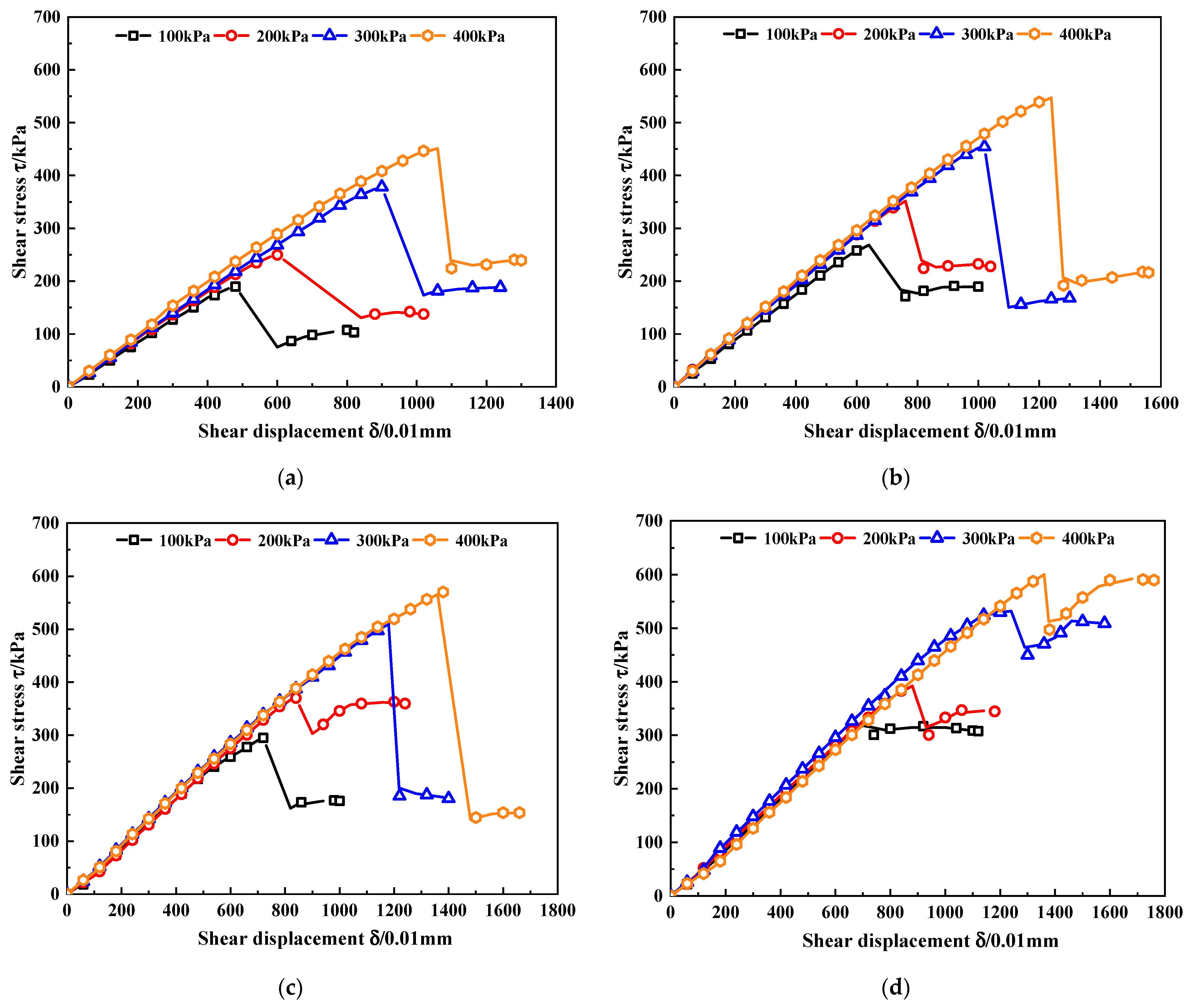
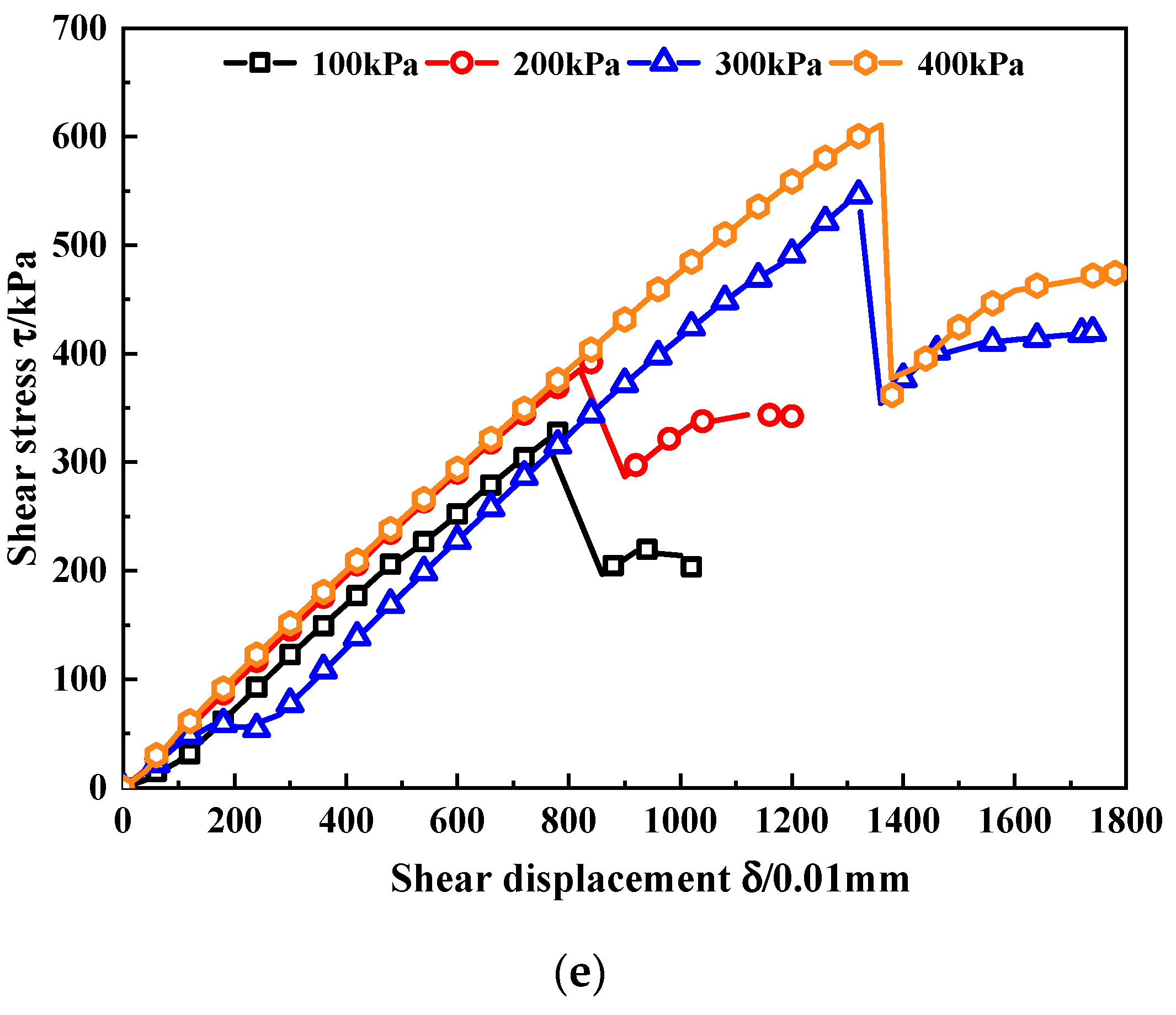
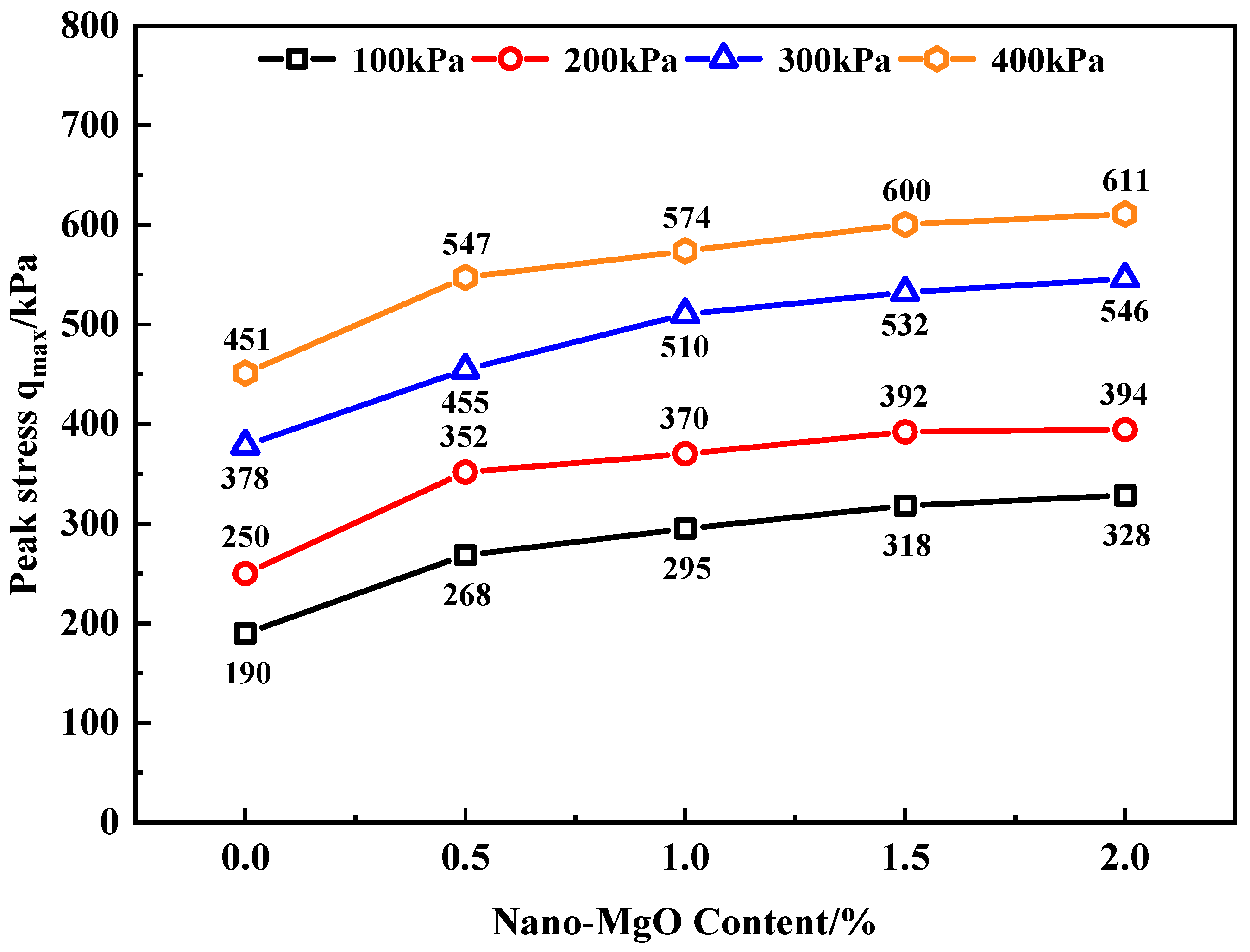
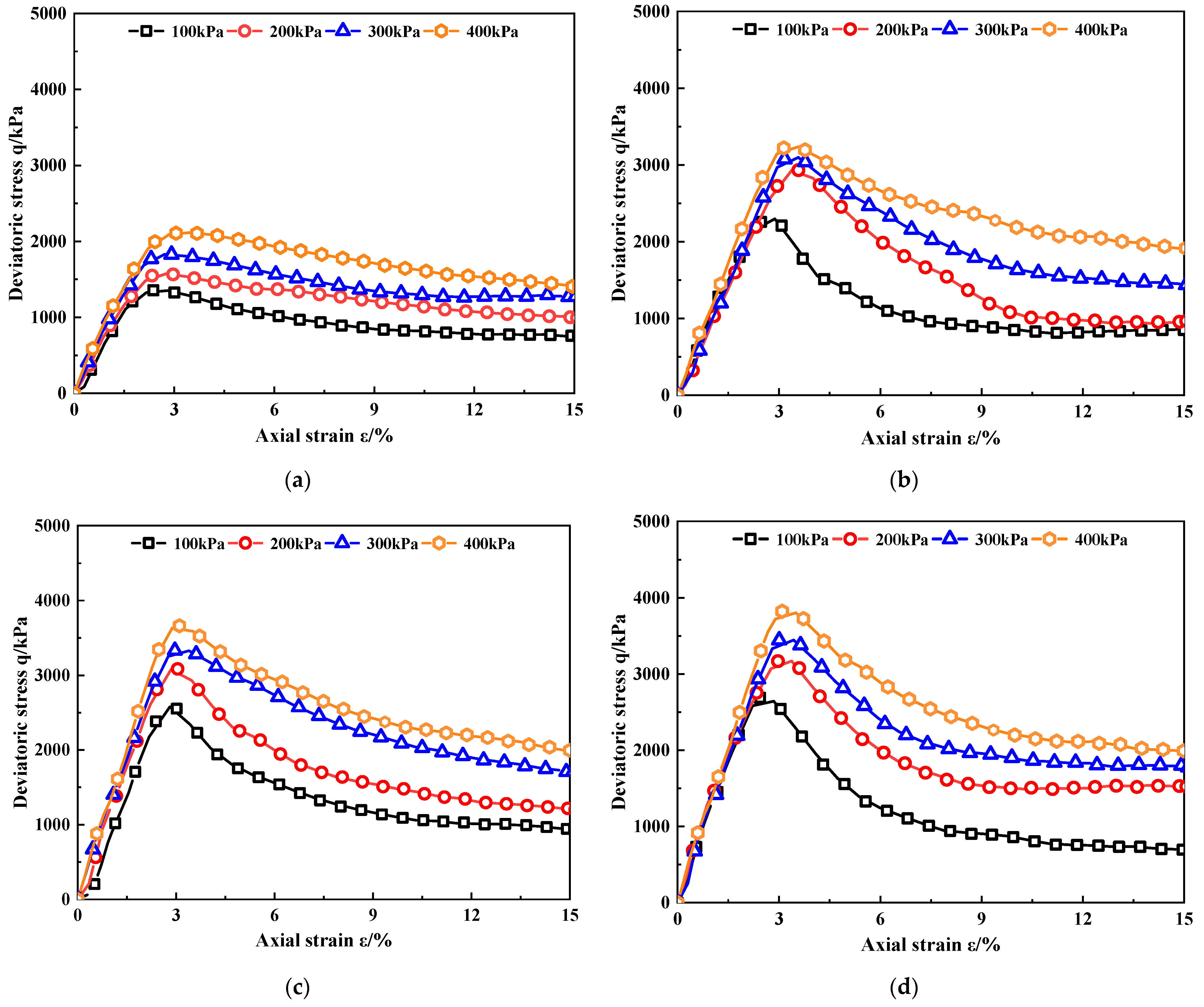
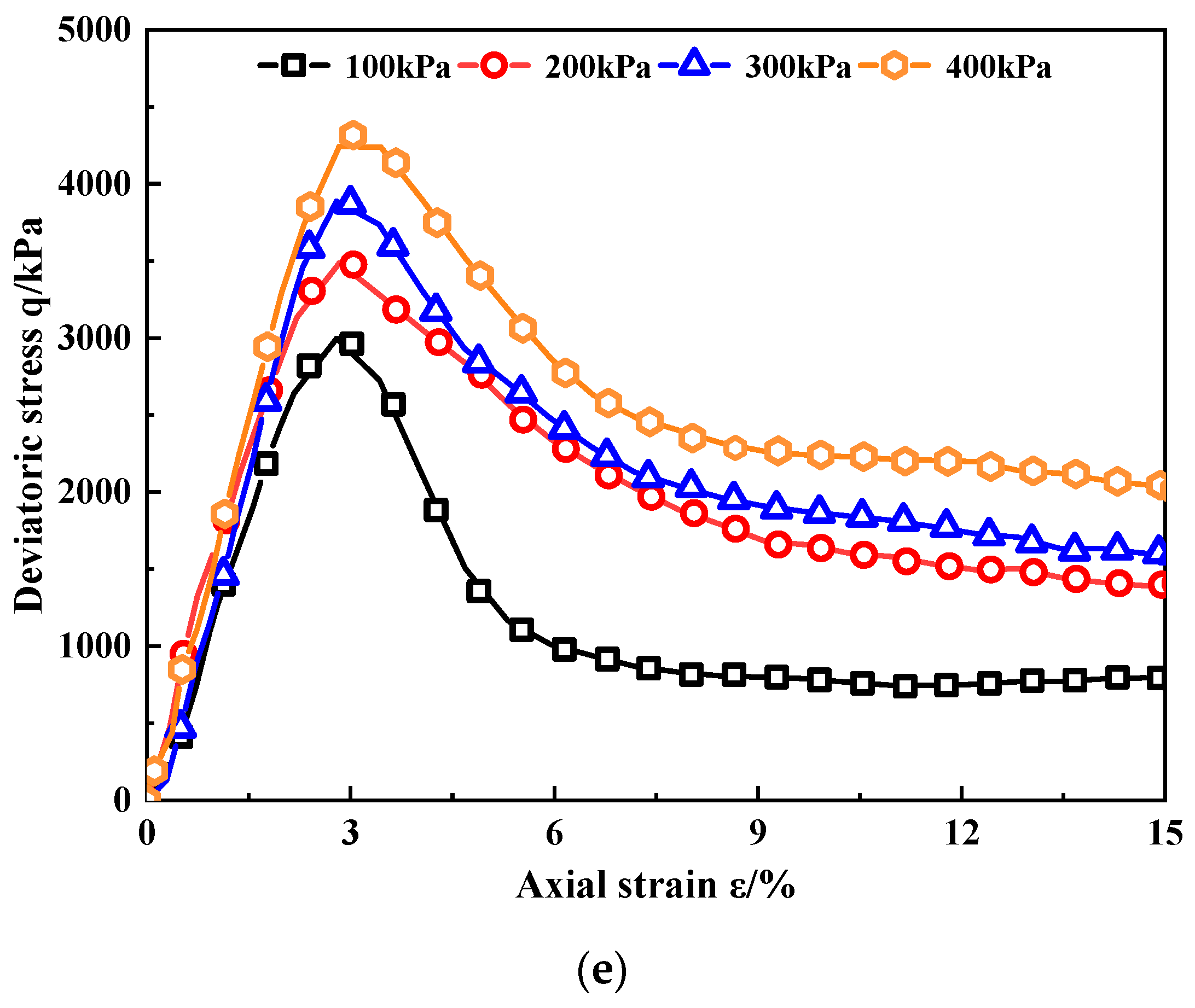
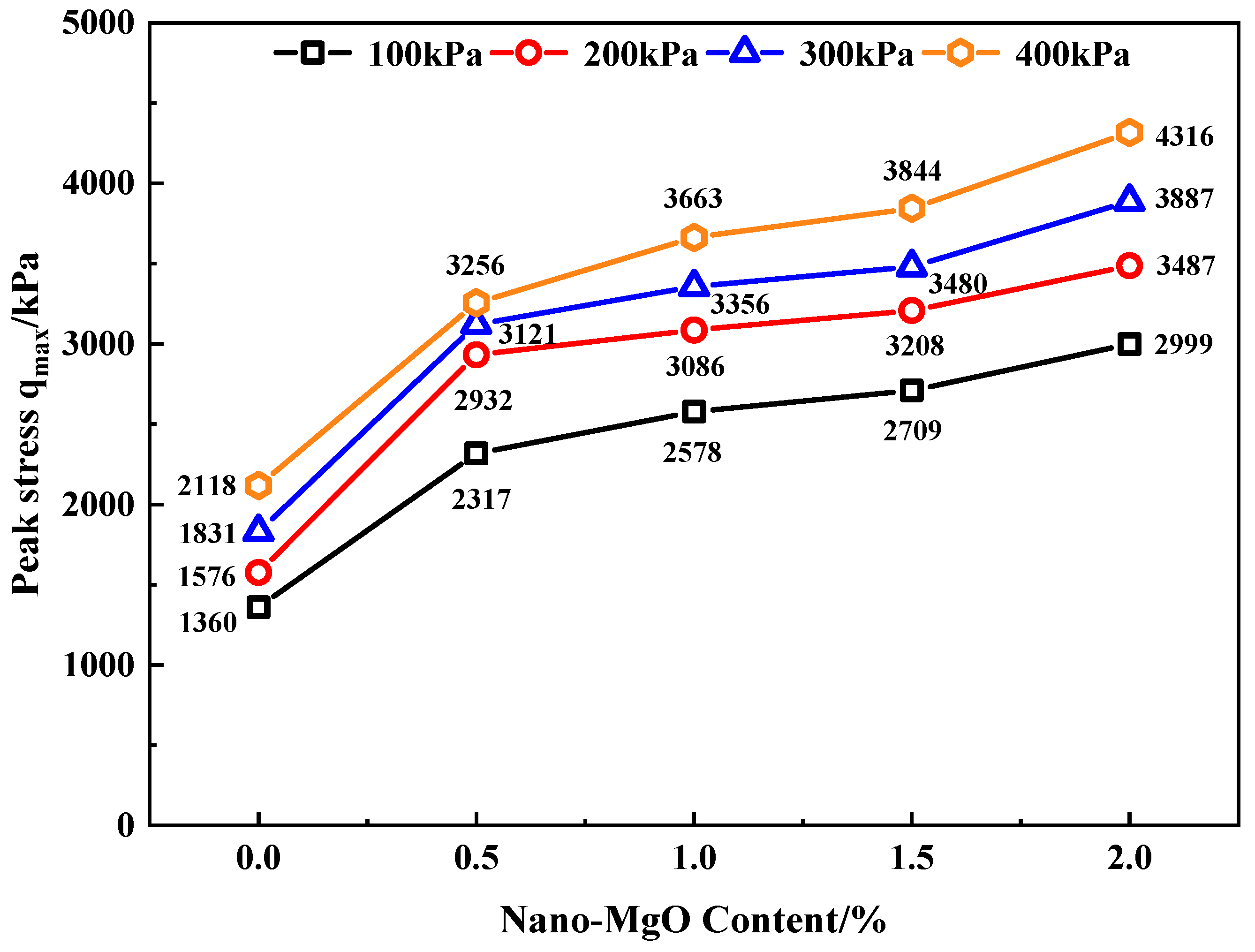

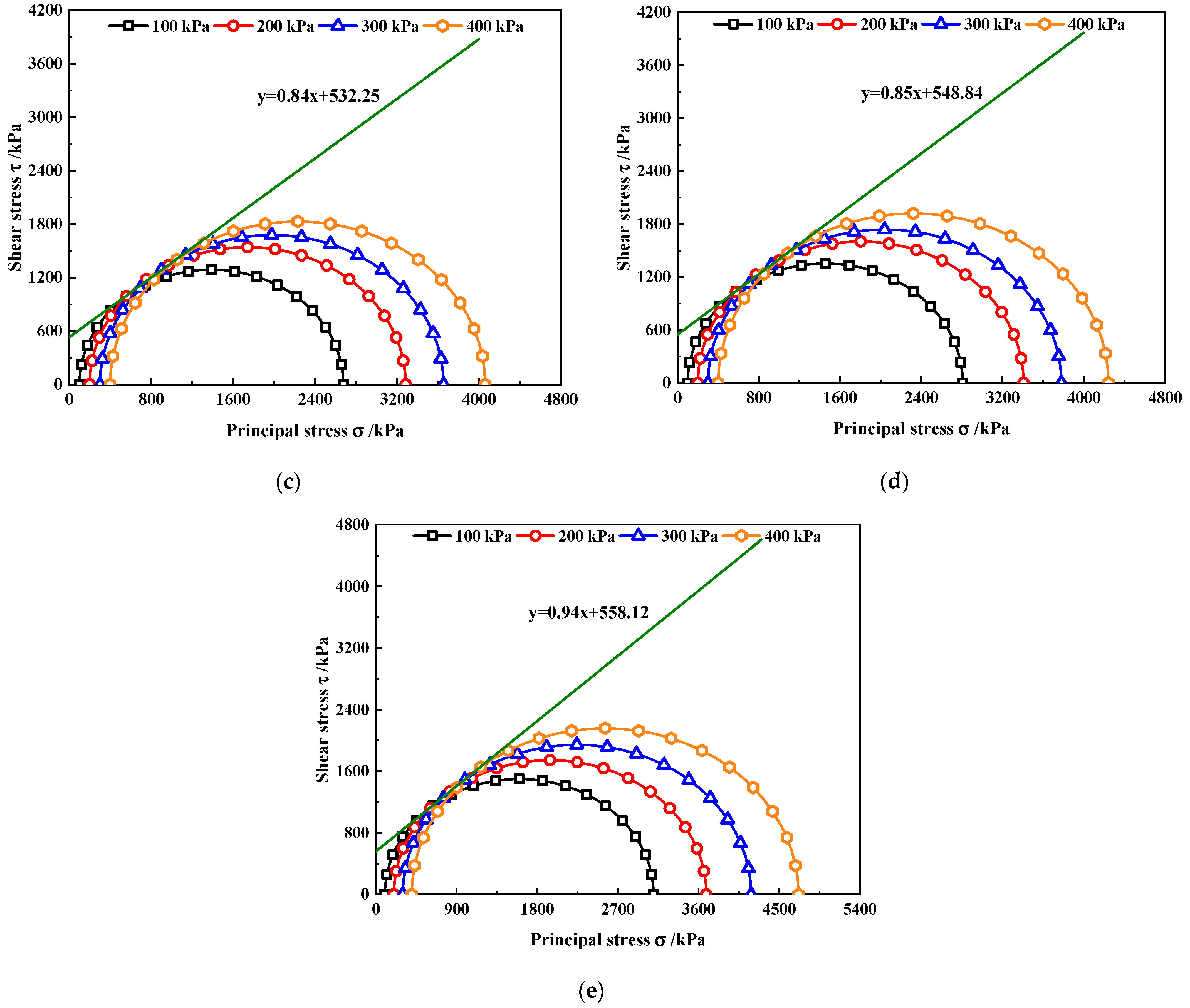
| Index | Moisture Content (%) | Plastic Index | Specific Gravity | Silt Content (%) | Apparent Density (kg/m3) |
|---|---|---|---|---|---|
| Value | 12.9 | 16.6 | 2.68 | 20.5 | 2.67 |
| Fineness (%) | Initial Setting Time (min) | Final Setting Time (min) | 3 Days Compressive Strength (MPa) | 28 Days Compressive Strength (MPa) | 3 Days Flexural Strength (MPa) | 28 Days Flexural Strength (MPa) |
|---|---|---|---|---|---|---|
| 3.4 | 210 | 295 | 26.9 | 48.1 | 4.9 | 9.0 |
| Product | Average Particle Size (nm) | Product Purity (%) | Theoretical Density (g/cm3) | Melting Point (°C) | Boiling Point (°C) | Crystal Form | Dispersity |
|---|---|---|---|---|---|---|---|
| Nano-MgO | 15–20 | 99.9 | 3.580 | 2850 | 3600 | Near spherical | Preparation by gas phase method |
| Sample No. | Cement Content (%) | Nano-MgO Content (%) | Normal Stress/Confining Pressure (kPa) | Moisture Content (%) | Curing Age (d) |
|---|---|---|---|---|---|
| MCRA0 | 2 | 0 | 100, 200, 300, 400 | 10 | 7 |
| MCRA0.5 | 0.5 | ||||
| MCRA1.0 | 1.0 | ||||
| MCRA1.5 | 1.5 | ||||
| MCRA2.0 | 2.0 |
| Sample No. | Strength Curve | Internal Friction Angle φ/° | Cohesion c/kPa |
|---|---|---|---|
| MCRA0 | τ = 0.913x + 31.65 | 42.38 | 89.06 |
| MCRA0.5 | τ = 0.939x + 61.21 | 43.20 | 170.61 |
| MCRA1.0 | τ = 0.976x + 67.97 | 44.31 | 193.16 |
| MCRA1.5 | τ = 0.987x + 75.22 | 44.61 | 213.98 |
| MCRA2.0 | τ = 0.998x + 76.87 | 44.95 | 220.35 |
| Sample No. | Strength Envelops | Internal Friction Angle φ (°) | Cohesion c (kPa) |
|---|---|---|---|
| MCRA0 | τ = 0.67x + 289.25 | 33.98 | 289.25 |
| MCRA0.5 | τ = 0.79x + 506.22 | 38.32 | 506.22 |
| MCRA1.0 | τ = 0.84x + 532.25 | 39.89 | 532.25 |
| MCRA1.5 | τ = 0.85x + 548.84 | 40.53 | 548.84 |
| MCRA2.0 | τ = 0.94x + 558.12 | 43.26 | 558.12 |
Publisher’s Note: MDPI stays neutral with regard to jurisdictional claims in published maps and institutional affiliations. |
© 2022 by the authors. Licensee MDPI, Basel, Switzerland. This article is an open access article distributed under the terms and conditions of the Creative Commons Attribution (CC BY) license (https://creativecommons.org/licenses/by/4.0/).
Share and Cite
Zhu, T.; Shou, Y.; Chen, X.; Lv, B.; Huang, X.; Yu, Y.; Li, C. Shear Behavior of Recycled Fine Aggregate Reinforced by Nano-MgO Modified Cement. Materials 2022, 15, 7188. https://doi.org/10.3390/ma15207188
Zhu T, Shou Y, Chen X, Lv B, Huang X, Yu Y, Li C. Shear Behavior of Recycled Fine Aggregate Reinforced by Nano-MgO Modified Cement. Materials. 2022; 15(20):7188. https://doi.org/10.3390/ma15207188
Chicago/Turabian StyleZhu, Ting, Yitong Shou, Xiaoqing Chen, Beifeng Lv, Xianwen Huang, Yanfei Yu, and Cuihong Li. 2022. "Shear Behavior of Recycled Fine Aggregate Reinforced by Nano-MgO Modified Cement" Materials 15, no. 20: 7188. https://doi.org/10.3390/ma15207188
APA StyleZhu, T., Shou, Y., Chen, X., Lv, B., Huang, X., Yu, Y., & Li, C. (2022). Shear Behavior of Recycled Fine Aggregate Reinforced by Nano-MgO Modified Cement. Materials, 15(20), 7188. https://doi.org/10.3390/ma15207188







